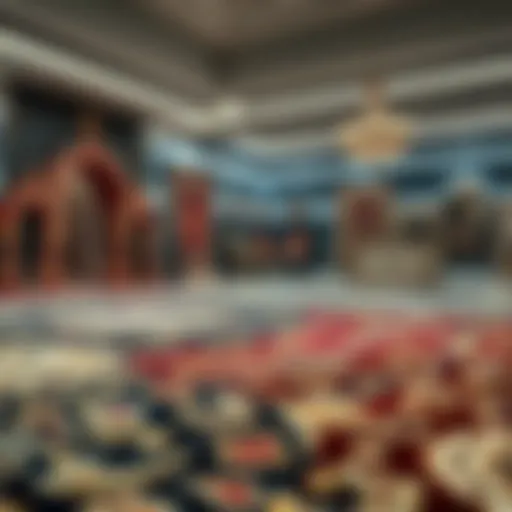Top Interior Design Companies Transforming Dubai Spaces
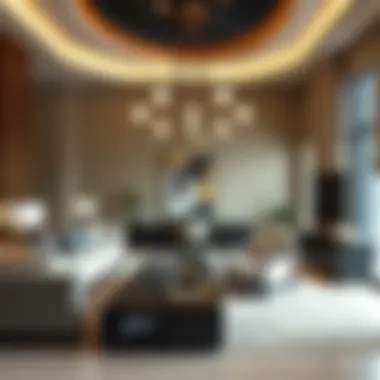

Intro
In the vibrant and dynamic city of Dubai, interior design companies play a crucial role in shaping both residential and commercial spaces. The landscape is as diverse as the people who inhabit it. Every nook and cranny reflects a tapestry of cultures, aspirations, and styles, creating environments that are not just aesthetically pleasing but also functional. As the real estate market booms, driven by investors and a growing expatriate community, these companies have become pivotal in curating personalized spaces that tell their client’s stories.
Each firm does not just operate on the surface of design; they delve into the psychology of space, understanding how a room can influence mood, productivity, and lifestyles. With a marked emphasis on sustainability, many are adapting to the local context while embracing global design trends. This article seeks to highlight the key elements of these companies, from their unique design philosophies and standout projects to the challenges they face in the ever-evolving market.
Market Trends
Current Property Prices
Understanding the pricing landscape in Dubai is essential for anyone looking to invest in interior design. Property values here soar, significantly impacting budget allocations for interior renovations and updates. Prices can fluctuate dramatically based on location, with prime areas like Downtown Dubai and Palm Jumeirah seeing higher price tags compared to more suburban locales. According to the Dubai Land Department, average property prices in these premier locations can reach up to $400 per square foot.
With the rise of luxury developments, designers often cater to high-net-worth individuals, creating bespoke interiors that justify the hefty investments. For the average homeowner or first-time renter, however, there are still affordable design solutions that don’t skimp on quality.
Future Market Projections
As for future trends, insights suggest sustained growth in the interior design sector, particularly as Dubai positions itself as a global hub for business and tourism. Key factors include:
- Sustainability: An increasing focus on eco-friendly materials and practices will shape design projects.
- Smart Homes: With technological advancements, more designs will integrate smart home features to enhance convenience and efficiency.
- Cultural Integration: As the city embraces its multicultural identity, design firms are likely to draw inspiration from different civilizations, merging these elements into contemporary aesthetics.
Prelude to Interior Design in Dubai
In the bustling metropolis of Dubai, interior design serves as a fundamental pillar that shapes not only the aesthetics of the city but also its cultural identity. The role of interior design transcends mere decoration; it encapsulates lifestyle, functionality, and local traditions, weaving them into the fabric of residential and commercial spaces. As investors, realtors, renters, developers, and homeowners delve into the market, understanding the significance of interior design becomes essential in navigating this dynamic landscape.
The vibrancy of Dubai is reflected through the diverse styles that emerge from its rich tapestry of cultures. From ornate Arabic motifs to sleek, minimalist contemporary designs, the fusion of these elements creates interiors that are both appealing and reflective of the city’s global character. Knowing how these styles influence local preferences can guide stakeholders in making informed decisions.
A notable aspect of interior design in Dubai is its relationship with the thriving real estate sector. As property developers strive to stand out in the saturated market, unique and thoughtful design can significantly enhance a property's desirability. The right interior design can elevate a space's functionality and aesthetic appeal, ultimately pushing property values upward and attracting a wider range of potential buyers and tenants.
Furthermore, exploring interior design is not just about appreciating beautiful spaces; it also involves comprehending the practical implications of design choices. Factors such as sustainability, compliance with local regulations, and cost-effective solutions all play a pivotal role in shaping successful projects. These considerations ensure that designs are not only visually captivating but also viable in the long term.
In this article, we will delve into the intricate details that characterize the interior design scene in Dubai. We will explore cultural influences, local market dynamics, and the challenges faced by designers. Through this exploration, we aim to equip the reader with insights that are not only informative but actionable, enriching their understanding of this vibrant industry.
Interior design is not merely about beauty; it serves as a dialogue between the builder and the inhabitant, resonating with purpose and identity.
In summary, the introduction to interior design in Dubai lays the groundwork for a thorough understanding of the sector. By emphasizing cultural influences and market dynamics, we set the stage for a deeper examination into the notable companies and their offerings, ultimately illuminating the journey toward crafting exceptional spaces.
Notable Interior Design Companies
The interior design landscape in Dubai is as dynamic as the city itself. Notable interior design companies play a pivotal role in transforming both residential and commercial spaces into aesthetically pleasing and functional environments. These firms are not only responsible for beautifying spaces but also for contributing significantly to the overall experience and lifestyle of Dubai’s diverse population. As the demand for unique and stylish interiors grows with the city’s expansion, identifying leading companies becomes imperative for homeowners, developers, and realtors alike.
Overview of Leading Firms
Within Dubai, several firms have established themselves as frontrunners, recognized for their innovative designs and commitment to quality. Companies like Aedas and Gensler have earned reputable status due to their remarkable projects that often marry contemporary aesthetics with local influences.
- Aedas: Known for its grand scale projects, Aedas specializes in blending modern designs with cultural elements, ensuring that every project resonates with the community’s identity.
- Gensler: A global architecture and design firm, Gensler tailors its approach to incorporate sustainability along with avant-garde styles, influencing both public spaces and businesses in unique ways.
Additionally, firms such as Design Haus Medyka and Gutting & Partners cater specifically to affluent clients, focusing on luxe home designs that convey elegance and sophistication. Their portfolios showcase an array of high-end residential projects that emphasize bespoke craftsmanship.
The competitive nature of interior design in Dubai means these firms continuously evolve, adapting to changing market demands while maintaining a high standard of excellence. Their reputation is often built not just on their visual output, but also on client satisfaction and the ability to deliver projects on time and within budget.
Emerging Trends in Design Companies
As Dubai’s landscape evolves, so too do the trends in interior design. Companies are increasingly focusing on:
- Sustainable Design: There’s a marked shift toward eco-friendly materials and energy-efficient designs. Many firms are now offering green solutions, reflecting global awareness about environmental impact.
- Smart Spaces: With technology becoming a central aspect of everyday life, interior design companies are integrating smart home technologies into their projects. This allows for greater control and customization in living and working environments.
- Cultural Sensitivity: Designers are becoming more attuned to the multicultural demographics of Dubai. By incorporating elements that resonate with various cultural backgrounds, firms are crafting designs that feel inclusive and authentic.
"The design ethos in Dubai is progressively focusing on functionality, culture, and sustainability. Firms that adapt will thrive in a market defined by rapid change."
In summary, knowing about these notable companies, their strengths, and emerging trends provides valuable insight for anyone looking to make informed decisions about interior design in Dubai. With an ever-changing marketplace, staying updated with leading firms’ capabilities and service offerings ensures one secures the best outcomes in their design endeavors.
Design Philosophy and Aesthetics
The philosophy behind design in the context of Dubai's interior scene is roughly like a melting pot, blending various elements into one dynamic experience. Design isn’t just about aesthetics; it's about creating environments that resonate with the people using them. Whether it's a luxurious high-rise or a cozy home, understanding the philosophy behind the choices designers make can unveil the unique character of each space. This section dives into how designers balance traditional motifs with contemporary elements and how sustainability plays into their overall aesthetic approach.
Balancing Tradition and Modernity
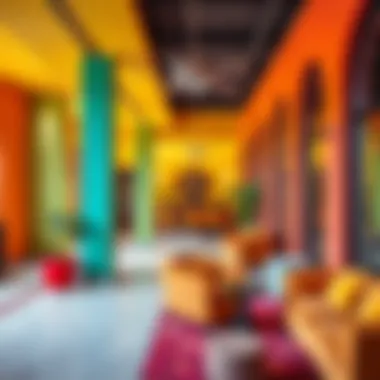

In Dubai, the dance between tradition and modernity is an ongoing saga. The city boasts a rich tapestry of cultural heritage that influences interior design. For instance, one can often find intricate arabesque patterns mixed with sleek, minimalistic furniture in many high-end residential projects. Designers are tasked with marrying the old with the new, giving spaces a sense of history while ensuring they meet modern lifestyle demands.
This balancing act offers several benefits:
- Cultural Significance: Infusing local and regional heritage into design not only honors tradition but also attracts clients who value cultural richness. A space that tells a story is more appealing.
- Innovative Solutions: By embracing modern methods and materials, designers can innovate traditional styles, introducing new functionalities without sacrificing aesthetic appeal.
- Client Connection: Today’s homeowners often seek designs that reflect both their personal tastes and their roots. A design philosophy that honors tradition creates a deeper emotional connection.
Some design firms, like Bishop Design, focus on curating experiences that celebrate local culture yet still feel modern and sophisticated. They blend innovative design approaches with cultural elements, creating spaces that feel timeless and forward-thinking simultaneously.
Sustainable Practices in Design
As the world becomes increasingly aware of environmental impact, sustainability in interior design emerges as a critical element for many firms in Dubai. Sustainable practices are not merely a trend; they reflect a commitment to ensuring that spaces benefit not just their occupants, but also the environment.
Key aspects of sustainability in design include:
- Material Selection: Many designers now prioritize eco-friendly materials, opting for items made from recycled and renewable resources. This not only reduces waste but also promotes a healthier living environment.
- Energy Efficiency: Incorporating energy-efficient lighting and appliances can significantly reduce the carbon footprint of a space. Many new projects in Dubai adopt smart home technology to ensure optimal energy use without sacrificing comfort.
- Waste Reduction: Designers are increasingly looking at how to minimize waste throughout their projects. This includes everything from the construction phase to the final detailing, ensuring as little material as possible ends up in the landfill.
A good example is Sustainable Spaces, a firm that emphasizes using local materials to reduce transportation emissions. They focus on designs that allow natural light to flood in, reducing the need for artificial lighting, which ultimately contributes to energy conservation.
"Sustainable design is not just a fad; it’s the future of how we live and work. Focusing on sustainable practices shapes our cities and preserves our planet for generations to come."
The confluence of design philosophy and aesthetics in Dubai reflects a growing awareness among interior design companies, highlighting their role in shaping both physical spaces and the broader landscape. Through the interplay of tradition, modernity, and sustainability, these designers create environments that are not only beautiful but also meaningful and responsible.
Service Offerings of Design Firms
In the bustling interior design landscape of Dubai, understanding the range of services provided by design firms can make all the difference when embarking on a project. Each firm has its unique flair and specialization, and the appropriate choice can enhance the desired project outcomes significantly. This section focuses on the critical services offered by design companies in Dubai, enabling potential clients to navigate options effectively.
Residential Design Services
When it comes to creating a home, residential design services occupy a special place. These offerings help transform ordinary spaces into personalized sanctuaries that reflect the individual inhabiting them. Interior designers engage deeply with clients to understand their preferences, lifestyles, and even their family dynamics.
Key aspects include:
- Space Planning: An efficient layout ensures every inch counts, maximizing functionality.
- Color Schemes: Colors evoke feelings; designers choose palettes that harmonize with personal styles.
- Furniture Selection: Tailored choices make a home inviting yet practical.
- Textiles and Finishes: Quality materials ensure durability and comfort, essential in a city known for its heat.
Ultimately, it’s about creating a space where memories are made, and this personalization is paramount.
Commercial Design Solutions
In terms of commercial design solutions, the stakes are often higher. Here, the designer must balance aesthetics with practicality and brand identity, ensuring that the space represents the company and facilitates productivity.
Consider the following elements:
- Brand Representation: A design should communicate the essence of a brand, from retail spaces to corporate offices.
- Functionality: Office layouts need to support workflow without creating clutter.
- Client Accessibility: For retail, how customers move through a space can affect sales directly.
- Sustainability Choices: More businesses prioritize eco-friendly materials, not just for compliance but also as part of their branding.
Often, the success of a business can be attributed to its carefully designed environment, making these solutions crucial.
Consultation and Project Management
Engaging a design firm goes beyond mere aesthetics; it encompasses consultation and project management, which are vital for a seamless execution. These services help clients navigate the complexities inherent in any design project.
Important considerations include:
- Initial Consultation: This phase is about setting expectations, timelines, and budgets, ensuring everyone is on the same page.
- Project Management: Coordinating between various stakeholders—contractors, suppliers, and clients—ensures that everything runs smoothly.
- Regular Updates: Keeping clients informed about progress can help build trust, reducing anxiety throughout the project.
- Budget Management: Good designers will help clients stay within their budget while optimizing the selections.
Ultimately, solid project management coupled with insightful consultation can elevate the interior design experience, making it less daunting for clients.
"The right interior designer not only crafts the space but also streamlines the entire process, ensuring the journey is as enjoyable as the outcome."
In summary, the service offerings from design firms in Dubai are tailored to meet a diverse range of needs—from the intimate touches of residential spaces to the impactful designs in commercial venues. Understanding these services can empower clients to select a firm that aligns with their vision and requirements.
Project Showcase
Highlighting the project showcase segment in this article is crucial for various reasons. First and foremost, it provides tangible examples of how interior design firms in Dubai bring their concepts to life. These showcases not only display the aesthetic prowess of designers but also illustrate their ability to respond to client instruction and the practical realities of each space. With Dubai's eclectic mix of cultures and architectural styles, showcasing projects becomes a means to understand how these firms navigate challenges while maintaining creativity and innovation.
Additionally, project showcases serve as an inspiration for potential clients, investors, and other stakeholders. By viewing completed projects, they can gauge the versatility and capabilities of various design firms. Furthermore, seeing the fruits of a designer’s labor can build trust and confidence in their work. Engaging with a designer becomes less daunting when one can reference previous successful projects, involving both residential and commercial spaces.
Residential Projects
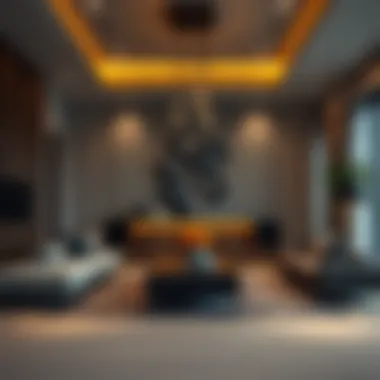

Residential projects undertaken by interior design companies in Dubai are often emblematic of luxury and personalization. Many families put their heart and soul into making their living spaces comfortable and aesthetically pleasing. In such cases, designers work closely with clients to transform their visions into reality. This partnership often involves a deep dive into the homeowner’s lifestyle preferences, cultural influences, and even architectural boundaries.
A notable example can be found in high-rise apartments where maximizing space and enhancing functionality are at the forefront of design. One specific design firm, Noura Interior Design, recently showcased a project in Jumeirah Heights. Here, the designer created a seamless blend of minimalist aesthetics with traditional Arabic elements, including intricate mashrabiya screens that serve both aesthetic and practical purposes.
Considerations for residential projects include:
- Client personalization and cultural relevance
- Integration of modern technology for smart home features
- Sustainable materials that harmonize luxury and responsibility
Commercial Spaces
When it comes to commercial spaces, the focus shifts from personal comfort to functionality and branding. Here, interior design plays a pivotal role in the customer experience and operational efficiency. Businesses often employ interior designers to create environments that not only represent their brand identity but also enhance the user experience.
One exemplary project can be seen in the design of the Dubai Mall’s newest event space. Here, the design firm Spacewell was tasked with a renovation aimed at promoting social interaction while facilitating various events. The result was a versatile area divided by modular partitions that can adapt to both small gatherings and large exhibitions. The brilliance was in executing a design that was both visually appealing and pragmatic, ensuring that each event held would benefit from an atmosphere conducive to engagement.
Key factors in commercial space design include:
- Brand identity through color schemes and layout
- Maximizing the flow of foot traffic to enhance customer experience
- Use of durable materials suitable for high-traffic areas
In summary, the project showcase section emphasizes the showcase of completed works by design firms as a reflective assessment of design capabilities in Dubai's vibrant market. Through the presentation of residential and commercial projects, a narrative of creativity intertwined with client needs is revealed, offering an enlightening perspective on what different designers can achieve in this ever-evolving landscape.
Client Engagement and Experience
Understanding client engagement and experience is crucial in the context of interior design firms in Dubai. As the real estate market continues to evolve, designers are recognizing that successful projects stem from solid relationships with their clients. Proper engagement not only clarifies project expectations but also fosters collaborative creativity that leads to innovative solutions.
Understanding Client Needs
Every client is unique; their requirements, preferences, and budgets can vary widely. Therefore, a keen understanding of client needs is foundational in crafting effective designs. Designers often start by conducting comprehensive consultations to grasp the lifestyle, taste, and functionality essential for each project. This may involve site visits, in-depth interviews, and even mood boards to visualize concepts.
Here are key aspects to consider when assessing client needs:
- Objective Understanding: Identify the primary goal, whether it is a residential space aimed at comfort or a commercial area focusing on branding.
- Cultural Sensitivity: Given Dubai’s diverse demographic profile, understanding cultural preferences can play a significant role in achieving design resonance.
- Budget Awareness: A candid discussion around budget constraints is necessary. This avoids costly surprises down the road and keeps the project on track.
- Lifestyle Fit: Consider how the design aligns with the client’s daily activities and long-term plans.
In this regard, successful interior designers in Dubai often implement tailored questionnaires or informal chats to gain insights. The goal is to weave the client's vision into the fabric of the design, making them feel heard and valued.
Communication and Feedback Processes
Once the initial understanding of client needs is established, effective communication throughout the design project becomes vital. Regular updates, transparent dialogue, and feedback loops ensure everyone stays on the same page.
Here are a few effective communication strategies:
- Scheduled Check-Ins: Establish regular meetings or calls to discuss progress and address any concerns. This keeps stakeholders invested in the project.
- Visual Presentations: Utilize renderings, sketches, and samples to illustrate ideas clearly. Visual aids foster better understanding and reduce miscommunication.
- Feedback Mechanisms: Create formal means for feedback, such as surveys or structured discussions. This invites input and adjustments before final decisions are made.
- Adaptability: Be open to changing course based on client feedback. The ability to pivot demonstrates responsiveness and commitment to delivering a satisfactory result.
Engaging clients throughout the design process not only creates a sense of partnership but also leads to higher satisfaction and better end results.
All these elements combined contribute to a streamlined process that respects the client’s vision while drawing from the designer’s expertise. Ultimately, success in design comes down to how well both parties engage with one another. A design that has the client’s essence is far more likely to resonate on both aesthetic and functional levels.
Challenges for Interior Designers in Dubai
Exploring the realm of interior design in Dubai brings to light a varied set of challenges facing professionals in this vibrant sector. The unique atmosphere of Dubai, characterized by rapid growth and cultural diversity, places a distinct set of demands on interior designers. Understanding these challenges is crucial for ensuring successful projects that meet client expectations and comply with local regulations. This section dives into two prominent challenges:
Regulatory Compliance Issues
Navigating the maze of regulatory compliance can feel like attempting to find a needle in a haystack. Dubai’s architectural landscape is governed by strict regulations and zoning laws which vary between emirates. This creates a challenging environment for interior designers as they must ensure their designs align with local codes and standards.
Missteps in compliance can lead to costly delays or even project cancellations—a headache no designer wants. For example, if an interior project in Dubai Marina fails to obtain the necessary permits before breaking ground, the entire plan could go south. Moreover, understanding fire safety regulations, accessibility guidelines, and building permits means designers need to stay up-to-date with frequent changes.
Designers are often caught between creative expression and the constraints imposed by laws, which can lead to frustration. Thankfully, many companies have built strong relationships with local authorities to streamline the compliance process. Engaging consultants who specialize in regulatory matters can also significantly ease this challenge, paving the way for more innovative and compliant design solutions.
Resource Availability and Cost Management
In a bustling city like Dubai, resource availability and effective cost management present intricate challenges to interior designers. Firstly, sourcing materials that fit both the aesthetic and budget can be an uphill battle. With the constant influx of foreign brands, local suppliers can sometimes struggle to meet demand, hindering timely project completion. Prices can fluctuate, so designers must always be on their toes, balancing quality with available resources.
Furthermore, the rise in demand for eco-friendly materials has made it imperative for designers to stay informed about sustainable options. Such materials might come with a heftier price tag, yet they offer long-term benefits in terms of durability and environmental impact.
Additionally, managing budgets for large-scale projects can often be akin to walking a tightrope. The unexpected costs generated by labor fluctuations, delays in supply chains, or sudden market changes can lead to project overruns.
Regular communication with stakeholders, meticulous planning, and proactive risk assessment strategies can help alleviate many of these concerns. Designers often utilize software and tools for real-time budget tracking, which fosters transparency and aids in decision-making. Lastly, engaging with clients to clearly define budgets at the outset can minimize disputes later in the project lifecycle.
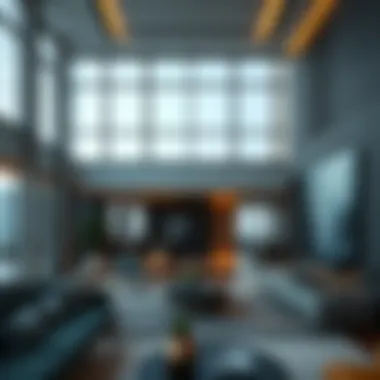

Overall, while the challenges facing interior designers in Dubai may seem daunting, they also present opportunities for growth and innovation. Tackling issues diligently can promote resilience and lead to exceptional design outcomes that capture the spirit of this remarkable city.
Future Directions in Interior Design
The realm of interior design in Dubai is continuously evolving, making future directions a crucial topic in understanding the broader implications for investors, homeowners, and developers. The design landscape here not only reflects current trends but also anticipates future needs. Recognizing these directions serves several purposes: helping clients make informed decisions, guiding designers in their creative processes, and aligning with global standards in the increasingly competitive market.
Innovations Impacting Design
Innovations in interior design are on the rise and significantly transforming how spaces are conceptualized. One cannot overlook how creative solutions are born from challenges, driving designers to think outside the box and embrace new materials and techniques.
- Biophilic Design: This trend has gained tremendous traction. By integrating elements of nature into spaces, designers create soothing environments that promote well-being. Think of incorporating living walls or natural light through strategic window placements.
- Flexible Spaces: With the rise of remote work, having a designated home office area has transitioned from a luxury to a necessity. Designers are crafting multifunctional spaces that can adapt as needs shift. Using modular furniture that can easily reconfigure ensures that spaces remain practical without sacrificing aesthetics.
- Smart Home Innovations: Smart technology plays a significant role in the future of design. Automation systems that manage lighting, heating, and security are not just enhancements; they offer a degree of convenience previously unheard of. Embracing such technology not only draws eco-conscious clients but also aligns with sustainability goals.
"Innovation is not just about new ideas; it's about making existing ideas better and more efficient."
The Role of Technology in Design
Technology weaves itself deeply into the fabric of modern interior design, influencing both the creative and operational sides of the business. Understanding this role is essential for anyone navigating this sector in Dubai.
- 3D Visualization Tools: Designers now rely on powerful software that allows clients to visualize designs in realistic formats. This technology minimizes miscommunication and ensures that clients’ visions are accurately represented. Programs like SketchUp or Revit can be game-changers, making the design phase far more efficient and clear.
- Virtual Reality (VR): Immersive experiences through VR can take client engagement to a new level. When clients can walk through a virtual version of their space, they're made privy to every detail before any physical work begins. This medium not only enhances client trust but can also result in quicker decision-making.
- Augmented Reality (AR): Similar to VR, AR bridges the gap between physical and digital worlds. It allows designers to overlay digital images of furniture and decor onto real environments, ensuring that each choice harmonizes with existing elements.
In summary, keeping an eye on the future directions in interior design, particularly through innovations and technology, offers a pathway for all participants in the Dubai real estate market. Understanding these dynamics not only enhances design experiences but ultimately leads to more successful projects overall.
The Importance of Selecting the Right Designer
Choosing the right interior designer can be the difference between creating a space that feels like home and one that feels utterly lacking. The significance of this choice cannot be overstated—after all, your living or working environment has a profound impact on both your day-to-day life and your overall well-being. A designer's expertise can enhance functionality, aesthetics, and even emotional comfort of a space.
When embarking on a design journey, one must consider various elements such as personal style, practical needs, and budget constraints. A well-chosen designer serves as both a partner and a guide, ensuring that your vision aligns with the necessary expertise. This collaboration ultimately paves the way for a space that resonates with you, effectively reflecting your identity and aspirations.
Moreover, understanding the nuances of local design trends and regulations in Dubai can be dizzying. A seasoned designer not only brings their creativity to the table, but also their knowledge of the regional market, enabling them to navigate the complexities of design projects seamlessly.
"The right designer can transform frustration into inspiration and confusion into clarity."
Besides style and functionality, a competent designer also contributes to enhancing the resale value of properties. This is especially true in a bustling market like Dubai's real estate scene, where an eye-catching interior can sway potential buyers. Thus, carefully selecting an influential designer can yield long-term financial benefits.
Credentials and Portfolio Review
When evaluating potential designers, one of the first steps is to scrutinize their credentials and past work. Ask for their official qualifications and certifications. An impressive degree from a reputed design school can speak volumes, but real-world experience is usually the cherry on top. Look for designers who have worked on varied projects—some minimalistic, others more opulent—showing their versatility and adaptability.
Reviewing their portfolio is also crucial. A solid portfolio showcases not only completed projects but the range of styles they’ve tackled. As you peruse their past work, pay attention to details: colors, materials, and how they interact within spaces. This will give you insights into whether their aesthetic aligns with your vision.
- Ask for Specific Examples: Rather than selecting designs that might just look good, engage in conversations about specific elements you like or dislike.
- Client Testimonials: Reach out to previous clients if possible. Their experiences can shed light on the designer’s process, reliability, and how they manage challenges that arise during a project.
Understanding Costs and Budget
Budget is often the elephant in the room when it comes to interior design. It can easily make or break a project, which is why understanding costs upfront is essential. Designers operate at various price points based on their experience, the scale of their projects, and even their distinctive brand identity. When assembling your budget, don’t just consider the designer’s fee; account for materials, furnishings, and potential unexpected expenses.
It helps to be transparent about your budget from the outset. A good designer will respect your financial parameters and work within them, advising you on where to splurge or save.
- Prepare for Surprises: Always factor in a cushion for unforeseen costs; this is a basic tenet of project management in any domain, including design.
- Discuss Value: Sometimes, a higher initial cost can lead to greater value in the long run, especially if it involves sustainable practices or innovative materials that save you money on upkeep.
Choosing the right designer requires a mix of logical scrutiny and gut feeling. By focusing on credentials, exploring portfolios, and establishing a realistic budget, you set the stage for a successful design collaboration that can turn your dreams into reality.
Closure: Crafting Spaces in Dubai
Creating spaces that reflect personal taste and functional needs is fundamental to the allure of interior design, especially in a place as dynamic as Dubai. This city, which bridges cultures and traditions, has become a canvas for inventive design perspectives. Crafting a space isn't just about aesthetics; it's about enhancing the quality of life for residents and users by improving their environment.
The Role of Interior Design in Enhancing Living Spaces
The essence of good interior design lies in the harmonious balance between form and function. Designers take into account not only what looks good but how spaces affect daily life. In Dubai, where architectural grandeur often overshadows the interiors, designers aim to create warm, inviting spaces. This means integrating elements that resonate well with the local culture, while also embracing innovative design practices.
Interior designers have the unique ability to curate spaces that promote comfort and inspiration. By selecting materials, colors, and layouts that encourage relaxation or productivity, designers serve a practical purpose. For instance, luxury apartments in Dubai's Marina often feature open layouts adorned with natural light, enhancing a sense of space and serenity.
Moreover, incorporating natural elements, like indoor plants or water features, can elevate a living space to new heights. Such touches can often be the difference between a stark environment and a lively, engaging space. Ultimately, the goal is to create an atmosphere where one feels at home, regardless of the hustle and bustle outside.
Final Thoughts on Design Choices
When it comes to making design choices in Dubai, one should look beyond mere trends. Design is deeply personal, often reflecting a home or business owner's identity. Thus, understanding one’s personal style, needs, and budget is vital in selecting the right designer and elements for the space.
Investors, realtors, renters, and homeowners should always carry out a thorough assessment before settling on design choices. It's essential to ask the right questions, review designers' portfolios, and ensure that their visions align with one's own. Budget constraints are often a reality, but knowing where to splurge and where to save can help achieve an ideal balance. For instance, investing in quality furnishings while opting for more affordable accessories can lead to a high-end look without breaking the bank.
Additionally, trends fluctuate with the seasons; therefore, one should aim for timeless elements that transcend the whims of fashion. Hand-picking pieces that resonate on a personal level can transform any corner of a room into a cherished nook.
In summary, crafting spaces in Dubai goes beyond just the physical layout. It's a thoughtful process steeped in culture, preference, and functionality. It’s about weaving the fabric of one’s life into their surroundings to foster comfort and inspiration. As the design landscape continues to evolve, staying informed and making mindful choices will ensure spaces remain not only beautiful but also meaningful and functional.



